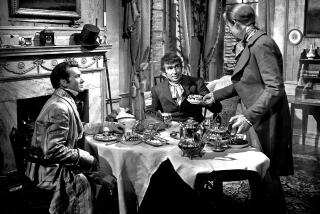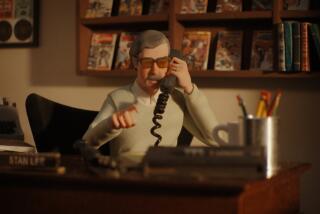Sir David Lean, Director of âLawrence of Arabia,â Dies : Movies: The Oscar winnerâs sweeping epics include âThe Bridge on the River Kwaiâ and âDr. Zhivago.â
Sir David Lean, the Oscar-winning director whose grandiose epics over six decades often made him a bigger star than many of his actors, died Tuesday in London.
His lawyer, Tony Reeves, issued a statement about his death but it did not disclose the cause.
Lean was 83 and had been hospitalized in Paris in January after being stricken on the set of what proved his final film, âNostromo,â based on the Joseph Conrad novel. Work on the film had since been suspended.
Lean, who once said he ânever thought (he) would have the luck to go into films,â was best known for directing such cinematic masterpieces as âLawrence of Arabia,â a sweeping adventure about the obsessive desert hero, and âThe Bridge on the River Kwai,â a critically acclaimed examination of the implacable madness of war.
His relatively few but meticulously crafted pictures--among them âDr. Zhivagoâ and âA Passage to Indiaâ--won 28 Academy Awards, including best director for âLawrenceâ and âKwai.â
âI donât know of any director who doesnât go down on one kneeâ whenever either film is discussed, director Steven Spielberg told Time magazine in 1984. âI feel a great reverence for David Lean. . . . Heâs the last of a generation of classical artists as picture makers.â
That sentiment was echoed by Sam Spiegel, who produced âKwaiâ and âLawrence.â âIn all my career,â Spiegel said in an interview with The Times in 1983, âI have not worked with anyone who remotely approaches Davidâs ability to put images on the screen.â
One of his final tributes came in March, 1990, when the American Film Institute named him the recipient of its Lifetime Achievement Award. Alfred Hitchcock, considered with Lean the greatest of the British film directors, had received the honor earlier.
Born the son of an accountant in the fashionable London suburb of Croydon, Lean grew up the older of two brothers in a strict Quaker household that looked with disapproval on the cinema. His initial exposure to movies came through the family charwoman he remembered as a âMrs. Egerton,â who would re-enact with great zeal the latest Charlie Chaplin film.
Mrs. Egertonâs performances so impressed the boy that, at 13, David began sneaking out of his Quaker boarding school to go to the local movie theater, eager to see what he had only imagined.
As he recalled decades later, the first film he saw was a 1921 version of Sir Arthur Conan Doyleâs classic Sherlock Holmes mystery âThe Hound of the Baskervilles.â
Lean was instantly captivated by âthat beam of light traveling through the smokeâ to create images on the screen. âIt had an immediate magic for me.â
But it was not until he was 19 that Lean embarked on his career in films after an unsuccessful yearlong stint at his fatherâs accounting firm. He was taken on without pay at Londonâs Gaumont Studios as a âgofer,â where his primary duties were to fetch tea and load film.
His enthusiasm was undampened, however, and quickly led him through the ranks. From unpaid underling he quickly became ânumber-board boy,â responsible for holding up the cards that designated camera takes. After a short time at this and other positions, including camera assistant, he eventually achieved the title of âthird assistant director.â
It was along that path that he discovered his first love of the movie business: editing. A sympathetic projectionist at Gaumont allowed Lean to join him in the projection booth to watch each dayâs rushes.
He channeled his efforts into editing, gaining experience at Gaumont Sound News and British Movietone News.
Newsreels gave way to features, and, at 30, Lean made a name for himself with his work on Gabriel Pascalâs successful production of George Bernard Shawâs âPygmalion.â In âPygmalionâ Lean first demonstrated the overriding concern for the visual image that would rule his future exploits--he ignored the soundtrack and used a silent-movie projector to edit the film.
âI like the excitement of finishing shooting and then starting with the first shot of Reel 1 and putting it all together myself,â Lean told The Times in 1984, as he was finishing direction of âA Passage to India,â which he also edited.
âI began as an editor, after all, and I love it,â he said, adding that in editing âthereâs just the film there. Nobody to argue with you or answer back.â
From editing, Lean turned his attention to directing.
His first assignment came in 1942, when playwright Noel Coward asked him to co-direct his wartime film âIn Which We Serve.â
Coward reportedly offered Lean two pieces of advice: âOne, donât pop out of the same hole twice (repeating yourself). Two, do what pleases you, and if what pleases you does not please the public, then get out of show business.â
âIn Which We Serveâ did please the public, and marked the beginning of a profitable pairing of Lean with Cowardâs material. With the help of two colleagues, he founded a production company, Cineguild, and went on to direct a screen version of Cowardâs classic comedy âBlithe Spiritâ with Rex Harrison and Constance Cummings.
Lean created a classic himself with his adaptation of Cowardâs âBrief Encounter.â Hailed as âa landmark among British films,â the story of the doomed liaison between a suburban housewife and a doctor won the award for the finest British production of 1945 at the International Film Festival in Cannes.
Years later, in an interview for Leanâs 1989 biography, Trevor Howard, star of âBrief Encounterâ remembered his director not only for Leanâs brilliance but for the mental anguish his sometimes truculent craftsmanship produced in many of his actors.
âBy the time David gets round to filming âGandhi,â Howard said slyly, âMahatma will have to be played by Katie Hepburn, because sheâll be the only actor still talking to him.â
Emboldened by his success with âBrief Encounter,â Lean, with his Cineguild partners, produced back-to-back adaptations of two Charles Dickens novels--âGreat Expectationsâ in 1946, which won three Oscars, and âOliver Twistâ in 1948, which cast Alec Guinness as Fagin.
A period of coolly received films followed, and the three Cineguild partners went their separate ways in 1950. Lean and his wife, actress Kay Walsh, had also decided to go their separate ways the year before, but not long afterward Lean married again, this time to actress Ann Todd.
Todd starred with Sir Ralph Richardson in Leanâs 1952 film âBreaking the Sound Barrier,â which had its origins in a newspaper account Lean read of a jet that unaccountably disintegrated in midair.
Critical acclaim was immediate. The film critic Henry Hart wrote, âWith this film Lean breaks through the thin but definite line that divides exceptionally good directors from great ones.â The movie won the British Film Academyâs award for the yearâs best picture, with Richardson taking the award for best actor.
Lean rode the crest of this wave into Hollywood, where many of the rest of his films would be produced, starting with âThe Bridge on the River Kwaiâ in 1957. Guinness, who later said he owed Lean âan enormous amountâ for launching his acting career, joined the director once again to star in the film that earned Lean his first Oscar.
The second came in 1962 with âLawrence,â the sumptuous picture for which Lean was best known for the rest of his career. Lean brought his legendary intensity to the project, which took three years to produce and more than a year to shoot. As âLawrenceâ producer Spiegel said, âDavidâs greatest virtue is his enormous concentration. Heâs deeply engrossed in what heâs doing and has an idee fixe about anything he does.â
Lean acknowledged his intensity in a 1989 interview with the New York Times, describing his approach as the result of âfalling in love, really. I become obsessed with a project.â
His single-mindedness spawned an unwavering quest for perfection in his work. Hepburn, a good friend of Lean who starred in his 1954 film âSummertime,â wrote in the introduction to his biography: âNothing gets in his way. Heâll stand and look and stare. He wonât be hurried. He wonât budge until he can smell perfection. Thatâs his aim, work or play.â
The perfectionist in Lean became legendary on the set of âLawrence.â In one scene, where a Rolls-Royce was shown driving up to a hotel, Lean reportedly insisted that the double-R insignia on the carâs axle be âabsolutely uprightâ when the car stopped.
âLawrenceâ won seven Academy Awards, including best picture.
In 1965, Lean oversaw yet another international spectacular, âDr. Zhivago,â the classic adaptation of the Boris Pasternak novel. The movie featured Julie Christie and Omar Sharif, the actor catapulted to fame for his role opposite Peter OâToole in âLawrence of Arabia.â
Then, however, the fertile field of Leanâs directing career experienced a long drought, starting in 1970, when âRyanâs Daughterâ opened to extremely poor reviews. âAfter âRyanâs Daughter,â â Lean said, âI had such terrible notices that I really lost heart.â
But he did not give up trying. For more than three years during the 1970s he attempted to film a remake of âMutiny on the Bounty,â a dream he had cherished for years.
Unfortunately, the dream became what Lean later called âthe biggest regret of my whole career.â An estimated budget of $50 million brought resistance from all the major studios. The screenwriter of âMutiny,â Robert Bolt, as well as two producers, withdrew one by one from the project until Lean was left with nothing.
Insult was added to injury when Orion Pictures picked up the project without Lean, who had abandoned the sea epic for other ideas, and released a version (âThe Bountyâ) starring Anthony Hopkins and Mel Gibson, directed by Roger Donaldson.
âIt was three yearsâ work wasted,â Lean said in 1984. âAnd the sad part is that it was the best script Iâve ever had. It was really a cracker, and it would have made a marvelous film. But after all that work, they pulled the rug from under me. Because of that I havenât gone to see the film that was eventually directed. . . .
âI just couldnât face it.â
The long dry period meant that when Lean geared up to make another film in the early 1980s, an adaptation of E. M. Forsterâs novel âA Passage to India,â few studios expressed interest. Lean found himself writing the script without payment as John Brabourne and Richard Goodwin, the filmâs producers, scouted for financial backers.
In the end, through a rather tortuous deal struck with EMI, Columbia Pictures and Home Box Office, the team received the go-ahead.
The director was back, and he had something to prove.
âThe most dreadful lies were told about me at the time. It was said that Iâd become swollen-headed, that I would ruin companies,â Lean fumed. âI heard the stories. . . . I was so furious when I heard the rumors that I thought, âIâll show them. Iâll make this film and Iâll make it quickly.â And from start to finish it took just over a year.â Lean was 76 at the time.
With Victor Banerjee, Peggy Ashcroft, Judy Davis and old friend Guinness leading the cast, and with Lean headlining as screenwriter-director-editor, the film opened in 1984 to a warm reception. Ashcroft won an Oscar for her role and said of Lean on Tuesday that âhe worked right up to the end, didnât he? And what an achievement that was.â
Afterward, with the focus of his intensity gone, Lean confessed to feeling the same sense of loss he felt when each of his films was completed.
âYou work for months with a group of people, itâs a circus and youâre the ringmaster, then suddenly itâs over and you are on your own--you feel a terrible sense of having been deserted, and lonely. It takes me two or three months to recoup.â
A knighthood by Queen Elizabeth II in June, 1984, recognizing his contribution to the arts, helped Lean recover his spirits.
So did settling down back in England, in a renovated wharf house along the Thames in Londonâs East End, after âliving out of a Rolls-Royce and suitcase for years.â
His energy for directing remained unflagged and the sharp-featured filmmaker, whose face was once described as âthe envy of a caricaturist,â returned one last time to his directorâs chair for âNostromo.â
In one of his final interviews--last year for the Times of London--Lean summed up his career in a single sentence:
âI just love telling stories.â
Lean was married for the sixth time in December to 51-year-old interior designer Sandra Cooke. He also is survived by a son, Peter. His funeral will be private with a public memorial to be scheduled later.
DAVID LEANâS GREATEST HITS Principal films directed by Lean:
âIn Which We Serveâ (with Noel Coward), 1942*
âThis Happy Breed,â 1944
âBlithe Spirit,â 1945
âBrief Encounter,â 1945
âGreat Expectations,â 1946*
âOliver Twist,â 1948*
âOne Womanâs Storyâ 1949
âMadeleine,â 1950
âBreaking the Sound Barrier,â 1952
âHobsonâs Choice,â 1954*
âSummertime,â 1955*
âThe Bridge on the River Kwai,â 1957*
âLawrence of Arabia,â 1962*
âDr. Zhivago,â 1965*
âRyanâs Daughter,â 1970*
âA Passage to India,â 1984*
*Readily available on videocasette
SOURCE: Associated Press, Los Angeles Times
REMEMBERING DAVID LEAN
A legacy of elegant majesty. F1
More to Read
Only good movies
Get the Indie Focus newsletter, Mark Olsen's weekly guide to the world of cinema.
You may occasionally receive promotional content from the Los Angeles Times.











